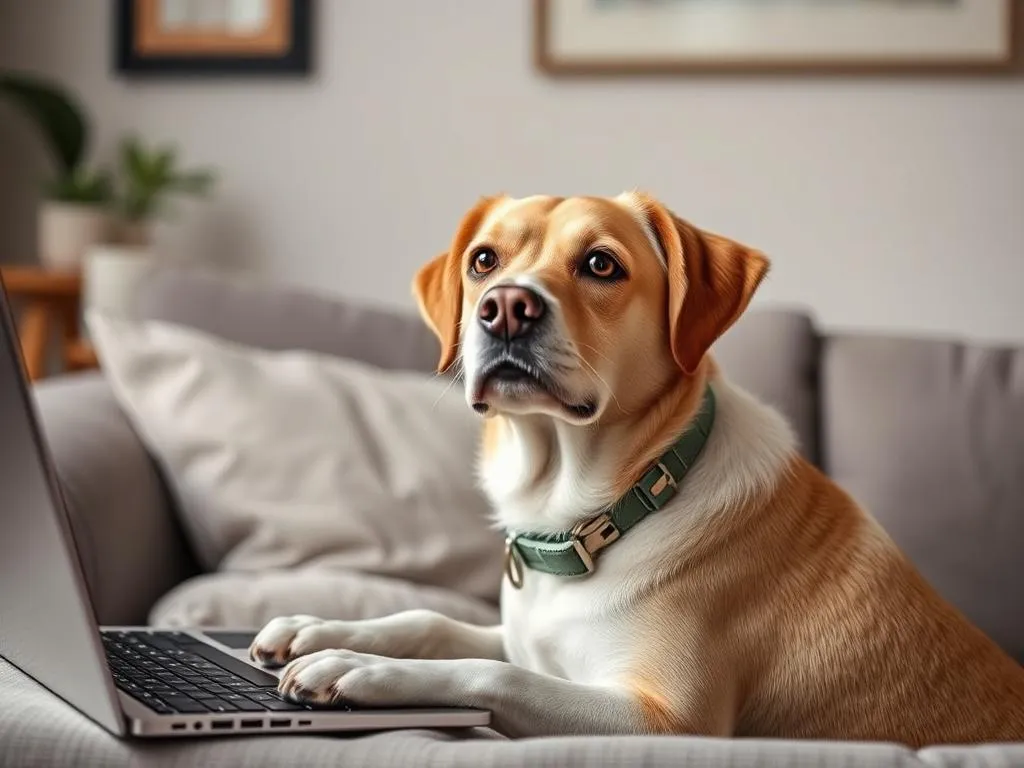
The rise of remote work has transformed how we balance our professional and personal lives, especially for pet owners. As more people find themselves working from home, the challenge of keeping pets engaged while maintaining productivity has become increasingly relevant. Dogs, with their affectionate nature and playful energy, often seek attention during work hours, leading to distractions that can hinder focus and efficiency. This article will explore practical strategies to ensure your dog remains calm and engaged while you work, all while keeping their needs met.
Understanding Your Dog’s Behavior
Common Reasons Dogs Distract Their Owners
Need for attention and affection is one of the primary reasons dogs may disrupt your workflow. Dogs are social creatures that thrive on interaction and companionship. When they notice you’re at home but not paying attention to them, they may resort to behaviors like barking or nudging you to get your attention.
Boredom and lack of stimulation are also significant factors. When dogs don’t receive enough physical and mental exercise, they can become restless and seek entertainment, often through disruptive behaviors.
Additionally, separation anxiety or stress can play a role in your dog’s distraction. Even when you’re physically present, some dogs may feel anxious when their owners are busy and unable to engage with them.
Recognizing Your Dog’s Signals
Understanding your dog’s behavior is crucial in addressing the distractions they cause. Look for body language indicators such as whining, pacing, or restlessness. These signals can reveal their need for attention or stimulation.
Vocalizations also provide insight into what your dog is experiencing. A low whine may indicate a desire for attention, while a more frantic bark could signal anxiety or boredom.
Finally, being aware of your dog’s routine and needs is essential. Regularly scheduled walks, meals, and playtimes can help minimize distractions and create a sense of security for your dog.
Creating a Productive Workspace
Designing a Dog-Friendly Home Office
To minimize distractions, consider where you set up your workspace. Choosing an ideal location is crucial; a quiet area away from your dog’s usual activities can help you maintain focus.
Setting up barriers can also be effective. Use baby gates or exercise pens to create a designated space for your dog, allowing them to feel safe while keeping them at a distance during work hours.
Incorporating dog-friendly furniture and accessories can enhance your workspace. A cozy dog bed or a comfortable crate nearby allows your dog to relax close to you without interrupting your work.
Establishing a Routine
Creating a consistent work schedule is vital for both you and your dog. Having set working hours helps your dog understand when it’s time for you to focus and when they can expect your attention.
Scheduling breaks for dog walks and playtime can create a balanced routine. Use these breaks to engage with your dog, giving them the attention they crave and allowing you to recharge.
Lastly, develop a daily routine that includes designated work and pet time. Consistency helps dogs feel more secure and reduces anxiety, leading to fewer distractions.
Engaging Your Dog
Structured Playtime and Exercise
Physical activity is essential for dogs to expend their energy and remain calm. Regular play sessions can significantly reduce distractions during your work hours. Consider quick games that can be completed in short bursts, such as fetch or tug-of-war.
Recommended dog toys for independent play include durable chew toys or interactive treat-dispensing toys that can keep your dog occupied while you work. These toys not only engage your dog’s attention but also provide mental stimulation.
Mental Stimulation Activities
In addition to physical exercise, dogs require mental stimulation to stay happy and engaged. Puzzle toys that dispense treats can provide hours of entertainment while challenging their minds.
Consider incorporating short training sessions during breaks to teach your dog new tricks. This not only reinforces good behavior but also strengthens your bond.
Engaging in interactive games like hide-and-seek or scent work can also keep your dog entertained while you focus on your tasks. These activities stimulate their natural instincts and provide a fun challenge.
Training Techniques
Teaching Commands for Focus
Training your dog to follow basic commands can significantly reduce distractions. Commands like “stay” and “settle” promote calm behavior, helping your dog understand when it’s time to relax.
Reinforcement techniques are crucial for successful training. Use positive reinforcement, such as treats or praise, to reward your dog when they comply with commands.
Practicing these commands during work breaks can help reinforce the behaviors you want to encourage, making it easier for your dog to understand their role during your work hours.
Implementing Positive Reinforcement
Positive reinforcement is key to effective training. Rewarding your dog for desired behavior encourages them to repeat those actions. Create a simple reward system where your dog receives a treat or praise for remaining calm while you work.
Consistency is essential in training, so ensure everyone in your household applies the same methods. This clarity helps your dog understand what is expected of them, reducing confusion and distractions.
Utilizing Technology
Dog Monitoring Tools
In today’s digital age, pet cameras and apps can be invaluable for monitoring your dog’s behavior while you work. These tools allow you to check in on your dog and ensure they are safe and calm.
Using monitoring technology can also help you interact with your dog remotely. Some cameras have two-way audio, enabling you to speak to your dog and reassure them when needed.
Interactive Gadgets
Consider investing in automated toys or interactive devices designed to keep dogs engaged. These gadgets can provide entertainment and stimulation, allowing you to focus on your tasks without constant interruptions.
However, it’s important to weigh the pros and cons of relying on technology. While these tools can be helpful, they should complement, not replace, your direct interaction with your dog.
Seeking Professional Help
When to Consider Dog Training Classes
If your dog exhibits persistent disruptive behaviors, it may be time to consider professional training classes. Signs that you might need help include excessive barking, destructive behavior, or difficulty following commands.
Look for classes that focus on your specific needs, whether it’s obedience training or more specialized sessions like agility training. A reputable trainer can provide guidance tailored to your dog’s personality and behavior.
Behaviorists and Veterinarians
If distractions stem from anxiety or stress, consulting a behaviorist may be beneficial. They can provide specialized strategies to address your dog’s behavioral issues.
Additionally, don’t overlook the role of veterinarians in addressing potential health-related distractions. Sometimes, underlying health problems can contribute to behavioral issues, and a veterinarian can help identify these concerns.
Conclusion
Keeping your dog from distracting you while working from home requires a combination of understanding their behavior, creating a suitable workspace, engaging them effectively, and implementing training techniques. By developing a structured routine, utilizing technology, and seeking professional help when needed, you can find a balance that allows you to remain productive while ensuring your dog is happy and well-cared for. A well-adjusted dog contributes to a harmonious work-from-home experience, promoting both productivity and a joyful home atmosphere.









